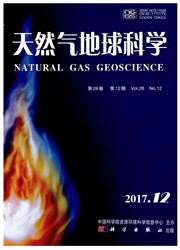

 中文摘要:
中文摘要:
柴达木盆地西北区(柴西北区)具备深层气藏形成的条件。柴西北区存在E1+2、E3^1、E3^2和N1 4套气源岩,其有机质丰度可达到中等到好;凹陷中心有机质类型以Ⅰ或Ⅱ型为主,凹陷边缘有机质类型以Ⅲ型为主;4套气源岩在茫崖凹陷和大风山鼻隆局部范围均达到高过熟阶段;总生气量达到1841.5×10^8m^3。柴西北区深层主要存在碎屑岩储层和裂缝性储层,前者主要分布于湖盆边缘的冲积扇相、河流洪泛平原相、扇三角洲相、辫状河相和滨浅湖相;后者主要分布于半深湖相。柴西北区深层存在3个生储盖组合,即:上生(E3^2—N1)下储(E3^2—E3^1)组合、下生(E3^2-N1)上储(N2^1-N2^2)组合和自生自储组合(E3^2-N1)。柴西北区深层区域性盖层主要是E3^2和N1湖泛时期形成的湖相泥岩。N2^1(23:5Ma)以后,柴西北区深层构造圈闭基本形成,相对完整的背斜和断背斜圈闭有油泉子、南翼山、油墩子和开特米里克。深层气运移主要以断层为输导层的垂向运移为主;背斜和断背斜构造囤闭一翼或两翼发育断层,对深层气的垂向运移非常有利。柴西北区气源岩生气期在23.5Ma(N2^1)以后,而大多数构造也是该时期以后形成的,因此柴西北区气源岩生气期与构造形成期同步。应用模糊评价方法,结合专家经验认为柴西北区深层气工类勘探目标为油泉子构造,Ⅱ类勘探目标为南翼山构造,Ⅲ类勘探目标为油墩子构造和开特米里克构造。深层气藏勘探的主要风险在于:①深层构造落实程度较差;②深层储层类型、分布和储层物性还不十分清楚。
 英文摘要:
英文摘要:
The northwestern Qaidam basin has the deep natural gas pool-forming conditions. There are four sets of gas source formations, the E1+2, E3^1 , E3^2 and N1 , which are medium to good source rocks based on organic matter abundance in the area. Organic matter mainly contains Ⅰ or Ⅱ type kerogen in the depression centre and Ⅲ type kerogen in the depression margin. Source rocks in the four formations are hypermature in the Mangya depression and partial area of the nose uplift of Dafengshan. The total volume of produced gas can be 1 841. 5× 10^8m^3. The deep part of the northwestern Qaidam basin mainly contains clastic reservoirs and fractured reservoirs. The former are fluvial fan, river plain, fan delta, braid river delta and lake shore facies, the later are semi-deep lake facies. The deep part of northwestern Qaidam basin has 3 source-reservoir-cap rock combinations, one is upper source (E3^2-N1)-lower reservoir (E3^2-E1) combination, one is lower source (E3^2-N1) upper reservoir (N2^1-N1) pool formation, and the other is self-source and self-reservoir (E3^2- N1 ) combination. The regional seal of the deep part of northwestern Qaidam basin is lacustrine mudstone which formed during lake-flooding in E3^2 and N1, mainly distribute in the inner part of the basin. Since N2^1 (23.5Ma), the deep structural traps, such asYouquanzi, Nanyishan, Youdunzi and Kaitemilike, have mostly formed as anticline and faulted anticline traps. Deep hydrocarbon migration are mainly through faulted transporting layer. It's favorable for deep gas vertical migration while many cracks developed in those anticline's wings. The period of generating gas was later than 23.5Ma(N2^1) in the most area of northwestern Qaidam basin, while most structural traps were formed after the period. Appling the method of fuzzy evaluation and professional experience, the authors consider Youquanzi as Class Ⅰ exploration target of deep gas in the northwestern Qaidam basin, Nanyishan as Class Ⅱ and Youdunzi and Kaitemili
 同期刊论文项目
同期刊论文项目
 同项目期刊论文
同项目期刊论文
 期刊信息
期刊信息
